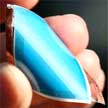Showing Spotlights 145 - 152 of 158 in category All (newest first):
 For several years now, researchers have documented the many intriguing mechanical and electrical properties of carbon nanotubes (CNTs). Some researchers have focused on the optical properties of CNTs. Studying the passive optical response of CNTs they have revealed the manner in which CNTs' optical properties are related to shape and structure of CNTs. It was found that periodic CNT arrays exhibit Bragg diffraction, photonic bandgap properties, and plasmonic resonance; nonperiodic CNT arrays interact with light waves similarly to the way in which radio antennae interact with radio waves. In conventional radio antenna theory an antenna acts as a resonator of the external electromagnetic radiation. Scientists now have demonstrated that a single multiwall carbon nanotube (MWCNT) acts as an optical antenna, whose response is fully consistent with conventional radio antenna theory.
For several years now, researchers have documented the many intriguing mechanical and electrical properties of carbon nanotubes (CNTs). Some researchers have focused on the optical properties of CNTs. Studying the passive optical response of CNTs they have revealed the manner in which CNTs' optical properties are related to shape and structure of CNTs. It was found that periodic CNT arrays exhibit Bragg diffraction, photonic bandgap properties, and plasmonic resonance; nonperiodic CNT arrays interact with light waves similarly to the way in which radio antennae interact with radio waves. In conventional radio antenna theory an antenna acts as a resonator of the external electromagnetic radiation. Scientists now have demonstrated that a single multiwall carbon nanotube (MWCNT) acts as an optical antenna, whose response is fully consistent with conventional radio antenna theory.
Feb 13th, 2007
 Along the way to all-optical devices in communication and information technology, photonic crystals play a significant role. They form a basis material for the future realization of optical components and circuits, and maybe even complex optical circuits or optical computers. Examples include complex waveguides, integrated microcavities, channel drop filters, optical switches and low-threshold lasers. All such devices depend on the inclusion of defect structures, non-linear materials and/or light-emitters into photonic bandgap material. The combination of several devices into one photonic crystal would allow to realize the optical equivalent of an electronic circuit. So far, the intentional inclusion of such combined structures was very difficult to realize in practice, however. A group of German and Italian researchers now present a powerful technique that allows to create such photonic circuits inside photonic crystals by controlled micro-infiltration of liquid substances with sub-micron resolution. This approach forms an enabling technology for the realization of all optical devices and circuits.
Along the way to all-optical devices in communication and information technology, photonic crystals play a significant role. They form a basis material for the future realization of optical components and circuits, and maybe even complex optical circuits or optical computers. Examples include complex waveguides, integrated microcavities, channel drop filters, optical switches and low-threshold lasers. All such devices depend on the inclusion of defect structures, non-linear materials and/or light-emitters into photonic bandgap material. The combination of several devices into one photonic crystal would allow to realize the optical equivalent of an electronic circuit. So far, the intentional inclusion of such combined structures was very difficult to realize in practice, however. A group of German and Italian researchers now present a powerful technique that allows to create such photonic circuits inside photonic crystals by controlled micro-infiltration of liquid substances with sub-micron resolution. This approach forms an enabling technology for the realization of all optical devices and circuits.
Dec 14th, 2006
 Artificial opals are gemstones that are of considerable scientific and technological interest as photonic crystals, as components of light sources, solar cells, and chemical sensors. They are conveniently made from periodic stackings of nanospheres. It would be exciting if one could fabricate optical cavities in these photonic crystals by removing, or adding high dielectric material to a single unit cell in the structure. These optical cavities would localize light that potentially enables the fabrication of high-resolution miniature on-chip sensors, or even qubits for quantum computers. Previously, such controlled modification of the nanostructure of a single colloid in an opal has not been achieved. Now, researchers in The Netherlands developed a method for realizing both single and arrays of material cavities, or defects, in individual colloids on the surface of silicon dioxide artificial opals by a focused ion beam milling technique. This research could ultimately lead to the fabrication of a photon-on-demand light source.
Artificial opals are gemstones that are of considerable scientific and technological interest as photonic crystals, as components of light sources, solar cells, and chemical sensors. They are conveniently made from periodic stackings of nanospheres. It would be exciting if one could fabricate optical cavities in these photonic crystals by removing, or adding high dielectric material to a single unit cell in the structure. These optical cavities would localize light that potentially enables the fabrication of high-resolution miniature on-chip sensors, or even qubits for quantum computers. Previously, such controlled modification of the nanostructure of a single colloid in an opal has not been achieved. Now, researchers in The Netherlands developed a method for realizing both single and arrays of material cavities, or defects, in individual colloids on the surface of silicon dioxide artificial opals by a focused ion beam milling technique. This research could ultimately lead to the fabrication of a photon-on-demand light source.
Nov 30th, 2006
 Photonic crystals are attractive optical materials for controlling and manipulating the flow of light. They can be engineered to produce a variety of optical filtering functions. The growing efforts of physicists and materials scientists to fabricate photonic (nano)crystals were motivated mainly by the potential application of these materials in optical computing, the manufacturing of more efficient lasers, and other exciting new phenomena, like those arising from the application of disturbances such as shock waves. The manufacturing of large-area photonic crystals operating in the visible spectrum is still a challenging and expensive task, given present-day laboratory techniques. However, as with so many other materials, nature has already found a solution. Because they are ready made, common in nature, and because they show a very high complexity, biological photonic-crystal structures will be an essential tool for building a useful knowledge of inhomogeneous optical media.
Photonic crystals are attractive optical materials for controlling and manipulating the flow of light. They can be engineered to produce a variety of optical filtering functions. The growing efforts of physicists and materials scientists to fabricate photonic (nano)crystals were motivated mainly by the potential application of these materials in optical computing, the manufacturing of more efficient lasers, and other exciting new phenomena, like those arising from the application of disturbances such as shock waves. The manufacturing of large-area photonic crystals operating in the visible spectrum is still a challenging and expensive task, given present-day laboratory techniques. However, as with so many other materials, nature has already found a solution. Because they are ready made, common in nature, and because they show a very high complexity, biological photonic-crystal structures will be an essential tool for building a useful knowledge of inhomogeneous optical media.
Sep 21st, 2006
 Cantilever based back-illuminated full body glass tips with thin metal layers can be used as apertureless optical near-field probes with single molecule sensitivity and optical resolutions down to 15 nm exceeding by far the classical diffraction limit of Abbe.
Cantilever based back-illuminated full body glass tips with thin metal layers can be used as apertureless optical near-field probes with single molecule sensitivity and optical resolutions down to 15 nm exceeding by far the classical diffraction limit of Abbe.
Jun 21st, 2006
 An electrochromic display is one of the most attractive candidates for paper-like displays, so called electronic paper, which will be the next generation display, owing to attributes such as thin and flexible materials, low-power consumption, and fast switching times.
An electrochromic display is one of the most attractive candidates for paper-like displays, so called electronic paper, which will be the next generation display, owing to attributes such as thin and flexible materials, low-power consumption, and fast switching times.
Jun 19th, 2006
 Optical labeling is an important tool in biological imaging because it offers superb discrimination between the sites of interest and the crowded background of a biological specimen. Diamonds nanocrystals have several advantages over other optical labels and open new opportunities in optical imaging, especially in applications where the size of optical labels represents an important parameter.
Optical labeling is an important tool in biological imaging because it offers superb discrimination between the sites of interest and the crowded background of a biological specimen. Diamonds nanocrystals have several advantages over other optical labels and open new opportunities in optical imaging, especially in applications where the size of optical labels represents an important parameter.
Jun 1st, 2006
 Researchers in Germany managed to integrate quantum dots (QD) into the walls of nano- and microtubes. This novel structure serves as a quantum light emitter as well as optical waveguide. This represents a major step toward the realization of flexible high quality factor optical resonators based on tubes.
Researchers in Germany managed to integrate quantum dots (QD) into the walls of nano- and microtubes. This novel structure serves as a quantum light emitter as well as optical waveguide. This represents a major step toward the realization of flexible high quality factor optical resonators based on tubes.
Apr 11th, 2006
 For several years now, researchers have documented the many intriguing mechanical and electrical properties of carbon nanotubes (CNTs). Some researchers have focused on the optical properties of CNTs. Studying the passive optical response of CNTs they have revealed the manner in which CNTs' optical properties are related to shape and structure of CNTs. It was found that periodic CNT arrays exhibit Bragg diffraction, photonic bandgap properties, and plasmonic resonance; nonperiodic CNT arrays interact with light waves similarly to the way in which radio antennae interact with radio waves. In conventional radio antenna theory an antenna acts as a resonator of the external electromagnetic radiation. Scientists now have demonstrated that a single multiwall carbon nanotube (MWCNT) acts as an optical antenna, whose response is fully consistent with conventional radio antenna theory.
For several years now, researchers have documented the many intriguing mechanical and electrical properties of carbon nanotubes (CNTs). Some researchers have focused on the optical properties of CNTs. Studying the passive optical response of CNTs they have revealed the manner in which CNTs' optical properties are related to shape and structure of CNTs. It was found that periodic CNT arrays exhibit Bragg diffraction, photonic bandgap properties, and plasmonic resonance; nonperiodic CNT arrays interact with light waves similarly to the way in which radio antennae interact with radio waves. In conventional radio antenna theory an antenna acts as a resonator of the external electromagnetic radiation. Scientists now have demonstrated that a single multiwall carbon nanotube (MWCNT) acts as an optical antenna, whose response is fully consistent with conventional radio antenna theory.
 Subscribe to our Nanotechnology Spotlight feed
Subscribe to our Nanotechnology Spotlight feed
